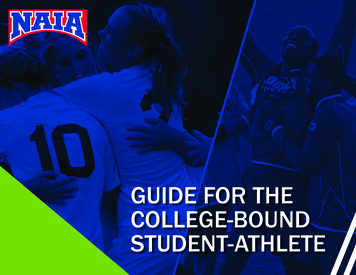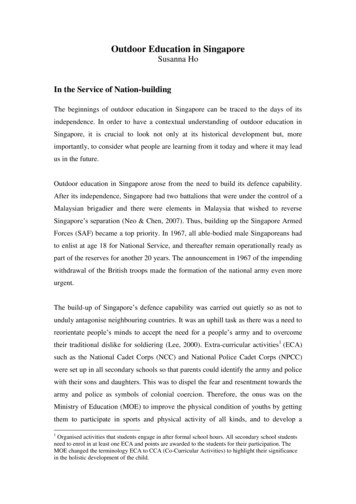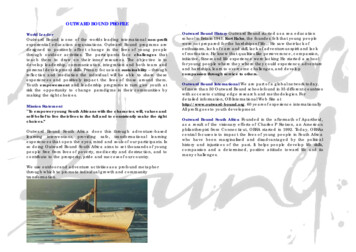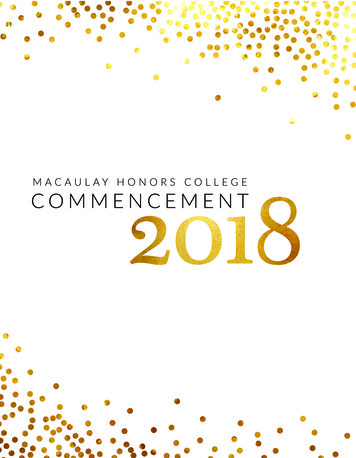
Transcription
GUIDE FOR THECOLLEGE-BOUNDSTUDENT-ATHLETE
NAIA GUIDE FOR THE COLLEGE-BOUND STUDENT-ATHLETE27 National ChampionshipsThe NAIA offers student-athletes the opportunityto compete at the highest level in these sports.Fall sportsMen’s Cross CountryWomen’s Cross CountryFootballMen’s SoccerWomen’s SoccerWomen’s VolleyballWinter sportsDear Prospective Student-Athletes,Welcome to the National Association of Intercollegiate Athletics, an association that boasts a proud tradition of intercollegiate athletics,academic excellence and character values.The National Association of Intercollegiate Athletics (NAIA), headquartered in Kansas City, Mo., is agoverning body of small athletics programs dedicated to character-driven intercollegiate athletics. Since1937, the NAIA has administered programs and championships in balance with the overall collegeeducational experience. The student-athlete is the center of all NAIA initiatives. Each year more than 77,000student-athletes have the opportunity to play college sports, earn over 800 million in scholarships andcompete for a chance to participate in 27 national championships.Today, the NAIA is an association that, above all other things, cares about and is focused on student-athletesuccess – helping you to attain your education and athletic goals. Our members utilize athletics as a vehicleto transform lives to build better futures.The NAIA is ready to assist you in taking that important first step in your college sports career. We invite youto register with the NAIA Eligibility Center at PlayNAIA.org.Spring sportsBaseballMen’s GolfWomen’s GolfWomen’s LacrosseMen’s Outdoor Track & FieldWomen’s Outdoor Track & FieldSoftballMen’s TennisWomen’s TennisMen’s VolleyballInvitational sportsWomen’s Beach VolleyballMen’s LacrosseWomen’s WrestlingEmerging sportsSince the NAIA’s founding in 1937, we are proud of the many accomplishments of our current and formerstudent-athletes and we look forward to the legacy you will establish in the NAIA. Visit us at NAIA.org.Women’s Flag FootballJim Carr, NAIA PresidentOPPORTUNITIES TO EXCEL IN COLLEGE SPORTSMen’s BasketballWomen’s BasketballMen’s BowlingWomen’s BowlingCompetitive CheerCompetitive DanceMen’s Indoor Track & FieldWomen’s Indoor Track & FieldMen’s Swimming & DivingWomen’s Swimming & DivingMen’s WrestlingFind NAIA schools that offersyour sport at naia.org/sportsNational Association of Intercollegiate Athletics 120 W. 12th Street, Suite 700 Kansas City, Mo. 64105 816.595.8000 NAIA.org PlayNAIA.org page 1
NAIA GUIDE FOR THE COLLEGE-BOUND STUDENT-ATHLETENAIA participation experienceWhat about financial aid, scholarships, grants, loans?In the NAIA, a student-athlete can compete during four “seasons of competition” within thefirst 10 semesters (or equivalent) in college. A season of competition is charged when youparticipate in one or more intercollegiate contests whether at the varsity, junior varsity orfreshman level, or in elite-level, non-collegiate competition. To compete, student-athletesmust be enrolled in at least 12 hours every semester or quarter and be making normalprogress toward a bachelor’s degree. They must also meet freshman and/or continuingeligibility rules.NAIA rules on financial aid are straightforward. Each school determines how much aid itawards to an individual student-athlete. Under no conditions may anyone else provide directfinancial assistance to any student-athlete. Scholarships, grants-in-aid or student loans arecontrolled by each institution through the same committee that handles all student loansand scholarships. TuitionWhat’s different about NAIA recruiting? Mandatory fees, books and supplies required for courses in which the student-athleteis enrolled Room and board based on the official room and board allowance listed in theinstitution’s catalogThe NAIA recruiting process for both freshmen and transfers is less cumbersome, with fewrestrictions on the contact between a student-athlete and a coach. More frequent communicationallows the student to become more comfortable with the school and athletics staff.Once you have started your college experience by enrolling and/or attending classes,representatives from another NAIA school cannot initiate contact with you. This no-contactpolicy applies even if you have not started classes yet, but have drawn equipment andbegun organized practice.What if you’re interested in transferring to an NAIA institution? Because NAIA coachescannot contact you, you’ll need to take that initiative by calling or emailing them. Oncecontacted, within 10 days the NAIA institution must notify in writing the athletics directoror faculty athletics representative at the school where you are currently enrolled. Theydon’t need permission to respond to you, but your current school must be notified that thecontact has been made.Can I visit a campus for a tryout?Students are permitted a maximum of two days of tryouts throughout their entire career.If a school has a policy for reimbursing all students for such visits, the same can be appliedto you as a prospective student-athlete.Financial aid to student-athletes is limited to the actual cost of:Each sport has an overall limit on the amount of financial aid it can award as full or partialgrants to students in that sport. For example, the overall limit in baseball is 12. Baseballscholarships can be awarded to any number of students (for example, 1 full scholarship,10 half awards and 24 quarter awards) as long as the combined total does not exceed 12.Limits on the total amount of aid that can be given to varsity athletes in each sport:Football. 24Basketball. 8Volleyball . 8Track & Field. 12Lacrosse. 12Cross Country . 5Swimming & Diving. 8Baseball. 12Softball. 10Competitive Cheer . 12Men’s Volleyball.8Golf. 5Academically gifted students can be exempted from these limits if they meet grade or testscore criteria established by the NAIA.Questions for parents to ask the NAIA institution about financial aid What types of financial-aid agreements doesyour school have?What about letters of intent?As an association, the NAIA does not have a letter of intent program in which students signa binding agreement to participate in athletics at a particular institution. Student-athletesmay sign letters of intent with an individual NAIA school, however, they aren’t obligatedto attend that institution. That said, some NAIA conferences require their member schoolsto recognize letters of intent that are signed with other institutions within the conference.Please check with your prospective school to see if any conference programs apply. Which campus representatives have to signoff on the agreement for it to be valid?Admission standards for athletes If my son or daughter signs a financialagreement with your institution, can she/he sign with another school within yourconference without penalty?To participate in athletics in the NAIA, you must be admitted to the college or universityunder admission standards equal to or higher than those applied to the general studentbody.OPPORTUNITIES TO EXCEL IN COLLEGE SPORTSSoccer. 12Tennis . 5Wrestling. 10Competitive Dance. 10Bowling . 5 What will the financial-aid agreement cover?Housing? Food? Books? Tuition? How long will the agreement last? Aquarter/semester? A full academic year? If my son or daughter quits the team afterthe season, will he or she continue toreceive the scholarship? If my son or daughter suffers a seasonending injury, will the financial-aidagreement be honored? If my son or daughter becomesacademically ineligible, will the agreementbe honored? On your campus, who is responsible forchecking the student-athlete’s eligibility? Is there an academic support program inplace for student-athletes on your campus? Do you offer my student’s major?National Association of Intercollegiate Athletics 120 W. 12th Street, Suite 700 Kansas City, Mo. 64105 816.595.8000 NAIA.org PlayNAIA.org page 2
NAIA GUIDE FOR THE COLLEGE-BOUND STUDENT-ATHLETEDo I meet the freshman eligibility requirements?What if I didn’t attend a U.S. high school?If you will graduate from a U.S. high school this spring and enroll in college this comingfall, the requirements are simple. An entering freshman must:The criteria for alternative high school experiences and those outside of the U.S. aredetermined as followsGED Students — must meet two of the three Be a graduate of an accredited high school. Meet two of the three following requirements. If as an entering freshman you donot meet at least two of the three standards.MUST MEET TWO OF THE THREE1. TEST SCOREREQUIREMENT2. HIGH SCHOOLGPA REQUIREMENT3. CLASS RANKREQUIREMENTAchieve a minimum of18 on the ACT or 970on the SATAchieve a minimumoverall high school gradepoint average of 2.0 ona 4.0 scaleGraduate in the tophalf of your highschool classTests must be taken on aninternational testing dateprior to the start of the termin which you intend to participate in athletics and scoresmust be achieved on a singletest date. The minimum SATmust be achieved on theEvidence-Based Reading &Writing and Math sectionsonly; the Writing score cannot be used.The NAIA accepts thegrade point average determined by the high school,provided it is recordedand awarded in the samemanner as for every otherstudent at the school.If a student’s class rankdoes not appear on thetranscript, a signed letterfrom the principal or headmaster, vice principal orguidance counselor writtenon the school’s letterheadand with the school’s officialseal, stating the student’sfinal class rank position orpercent may be submitted.Minimum score requirementsfor tests taken prior to May1, 2019 varied. For tests taken prior toMarch 1, 2016: 18 ACT,860 SAT (reading, math) For tests taken betweenMarch 1, 2016 and May1, 2019: 16 ACT, 860 SAT(evidence-based reading& writing, math)Exception: Completionof nine institutional credithours prior to identificationat any institution of highereducation can be used ifno class rank appears onthe final official high schooltranscript. The credit hoursmust be completed with agrade of “C” or better.Mid-Year Eligibility Opportunity. If you do not meet requirements for an enteringfreshman, you can satisfy one of the initial requirements in addition to earning 12 institutional credits hours with a grade of “C” or better during your first term of attendance atyour NAIA school to be eligible.Learning disabilities. Students with diagnosed learning disabilities, who do not meetthe freshman eligibility requirements, may have their academic profiles reviewed reviewedby the NAIA Learning Disability Advisory Committee at the request of an NAIA institution.The LDAC will then provide recommendations to the National Eligibility Committee to assistwith a final decision.OPPORTUNITIES TO EXCEL IN COLLEGE SPORTS1. TEST SCOREREQUIREMENTAchieve a minimum of18 on the ACT or 970 onthe SAT2. HIGH SCHOOLGPA REQUIREMENTGED students arerecognized as having metthe GPA requirement.3. CLASS RANKREQUIREMENT(Not applicable)Home Schooled StudentsTEST SCORE REQUIREMENT — Home school students who have a 20 on the ACT or1040 on the SAT are considered to have met the freshman eligibility requirement.If a home schooled student completes a home schooling program conducted in accordance with the lawsof the student’s state of residence, but does not meet the test score requirement, a home school waivermay be requested from the NAIA Home School Committee. They can also become eligible without atest score by completing nine institutional credit hours with a “C” or better prior to identification at anyinstitution of higher learning. Coursework must be accepted as institutional credit on the certifying NAIAtranscript and be shown as earned prior to the term in which the student wishes to compete.International Students — must meet two of the threeGraduates of high schools outside of the United States or one of the U.S. territories.1. TEST SCOREREQUIREMENTAchieve a minimumof 18 on the ACT or970 on the SAT2. HIGH SCHOOLGPA REQUIREMENTAchieve a minimum overall high school gradepoint average of 2.0on a 4.0 scale3. CLASS RANKREQUIREMENTGraduate in the tophalf of your highschool classException: Completion ofnine institutional credit hoursprior to identification at anyinstitution of higher educationcan be used if no class rankappears on the final officialhigh school transcript. Thecredit hours must be completed with a grade of“C” or better.International students must provide their academic records in boththe language of issue as well as word-for-word English translation.Note: For detailed information about the process for international students, please see theNAIA Guide for the International Student-Athlete.National Association of Intercollegiate Athletics 120 W. 12th Street, Suite 700 Kansas City, Mo. 64105 816.595.8000 NAIA.org PlayNAIA.org page 3
NAIA GUIDE FOR THE COLLEGE-BOUND STUDENT-ATHLETENAIA Eligibility Center at PlayNAIA.org determineseligibility of all first-time NAIA student-athletesThe NAIA Eligibility Center, at PlayNAIA.org, is responsible for determining the NAIAeligibility of first-time student-athletes. Students must receive an eligible decision bythe NAIA Eligibility Center prior to competing for the first-time in the NAIA, and all NAIAschools are bound by the center’s decisions.Every student interested in playing sports at NAIA colleges for the first time needs toregister online with the NAIA Eligibility Center and receive an eligible determination.This applies to high school seniors and transfers from both two- and four-year colleges.What information will I need to provide? You’ll create a personal profile with the basicfacts about your academic history and sports participation to date. You’ll need your current contact information, previous residences and addresses,high schools attended and history of your sports participation during and after highschool graduation. When you register for the ACT or SAT, include the NAIA EligibilityCenter (9876) on the list of places test scores should be sent.Ask your high school counselors to send a final, official transcript that verifies highschool graduation, class rank and cumulative grade point average to the eligibilitycenter through the NAIA High School Portal.What are the costs?Registration costs for students areas follows:Do I need to register with the NAIA Eligibility Center if I’mregistering with the NCAA?Yes, determining if you meet eligibility requirements for NAIA eligibility is separate fromNCAA eligibility certification. The NAIA and NCAA are two separate associations, with twodifferent sets of rules and certification processes.Early decisions for high school seniorsStudents, who have completed their junior year of high school and have at least a 3.0GPA on a 4.0 scale (2.5 on a 4.0 scale midway through senior year) and the minimum testscores required, may obtain an eligibility determination before graduating from high school.Those students will need to request that their official transcripts after their junior year besent to the NAIA Eligibility Center and contact ACT or SAT to have their test scores sentdirectly.Register with the NAIA Eligibility Center at PlayNAIA.org. Canada: 90 International: 150NAIA Eligibility Center US/Canadian freshman break: 135 US/Canadian break: 150This is a one-time, nonrefundable registration fee and includes all services for the studenttype. Additional fees may be assessed if your student type changes.Phone: 816.595.8300Hours: Monday-Friday8:30 a.m. to 5 p.m. CentralContact UsAddressNAIA Eligibility Center120 W. 12th StreetSuite 700Kansas City, Mo. 64105The registration fee will be waived for U.S. students with demonstrated need. If youreceived a fee waiver for the ACT or SAT test or received federal free or reduced-cost lunchprogram, contact your high school counselor, who can provide confirmation of your eligibility for a fee waiver to the NAIA Eligibility Center. Fee waiver confirmations are required tobe completed by high school counselors through the online NAIA High School Portalregardless of when you graduated high school.OPPORTUNITIES TO EXCEL IN COLLEGE SPORTSNational Association of Intercollegiate Athletics 120 W. 12th Street, Suite 700 Kansas City, Mo. 64105 816.595.8000 NAIA.org PlayNAIA.org page 4
NAIA GUIDE FOR THE COLLEGE-BOUND STUDENT-ATHLETEWhat are the transfer student eligibility requirements?Who’s considered a professional in the NAIA?If you have taken time off between high school and coming to the NAIA or have attendedtwo- or four-year college, the NAIA considers you a transfer student, regardless of whetheryou participated in intercollegiate athletics.In the NAIA, only amateur students-athletes are eligible to participate in a given sport.An amateur engages in athletics contests for educational values, personal pleasure, satisfaction, and for the love of the sport, not for monetary or material gain. If you becomea professional in a particular sport recognized by the NAIA, you will be considered a professional in that sport only and are ineligible for intercollegiate competition in that sport.If you’re a transfer who has never participated in athletics at an NAIA school, you’ll need toregister with the NAIA Eligibility Center at PlayNAIA.org to have your eligibility determined.Residency Rules if transferring from a four-year school — If you participated in anintercollegiate contest in your sport at your immediately previous four-year school, you mustwait 16 weeks before participating in that sport unless you: Have a written release from the athletic department at your most recent four-yearcollegeThe following will cause a student to lose amateur standing: Signing a contract with any professional team or entering into an agreement tocompete in professional athletics, with either a professional sports organization orwith any individual or group of individuals authorized to represent the athlete with aprofessional sports organization Participating in any athletics contest as a professional or as a team member whereyou receive reimbursement, directly or indirectly, exceeding the actual expenses oftravel, meals and lodging Receiving remuneration for any appearance or advertisement/promotion thatreferences the student’s collegiate institution or intercollegiate athletic participation.Have a minimum 2.0 GPA from all previous colleges combinedMeet all additional academic requirements and any conference-specific requirementsfor transfersResidency Rules if transferring from a two-year school — A student transferring froma two-year school has no residency requirement. If, however, you have participated at afour-year college prior to attending a two-year school, you must have a writtenrelease from the athletic department of the four-yearinstitution.24/36 Hour Rule — Transfer students are required tohave completed 24 semester/36 quarter hours of institutional credit in their last two semesters/three quarters offull-time enrollment prior to transferring.No, there is no age limit for participation in the NAIA. Instead, students are restricted to four seasons of competition in a given sport and have 10 university semestersto complete those four seasons of competition.How long can I compete?In the NAIA, a “season of competition” is charged when you participate in one ormore intercollegiate contests whether at the varsity, junior varsity or freshmanlevel, or in elite-level, non-collegiate competition. Student-athletes can competeduring four seasons of competition within the first 10 semesters (or equivalent) they are in college. For transfers, seasons of competition at the previousinstitution(s) are determined under the rules of the association (such as theNCAA, NJCAA, etc.) under which you competed previously. Non-collegiatecompetitive experiences are assessed using the evaluative criteria to determinepotential additional seasons of competition used.Progress Rule — If you’re a transfer student who hasalready used one or more of your four seasons of competition in college sports, you will need to show completion ofthe following before you can compete in your second, third,or fourth season: Second season: 24 semester/36 quarter totalcumulative credit hours Third season: 48 semester/72 quarter total cumulative credit hours Fourth season: 72 semester/108 quarter total cumulative credit hours(including 48 semester/72 quarter hours in general education or yourmajor field of study)OPPORTUNITIES TO EXCEL IN COLLEGE SPORTSIs there an age limit in the NAIA?What happens if I suffer an injury during college?If as a student-athlete you suffer a season-ending injury or illness, NAIA rules providefor a way to deal with the loss of the opportunity to compete. Hardship requests must beverified by the medical doctor who treated you. The injury cannot have occurred in lastregular season contest or during postseason, and you cannot have competed in morethan a specified number of contests. If granted, hardships restore a season of competition but do not restore any terms toward the maximum 10 semesters/15 quarters.National Association of Intercollegiate Athletics 120 W. 12th Street, Suite 700 Kansas City, Mo. 64105 816.595.8000 NAIA.org PlayNAIA.org page 5
NAIA GUIDE FOR THE COLLEGE-BOUND STUDENT-ATHLETEWhat if I’ve competed in my sport outside of college?Athletes who compete outside the traditional college setting can gain an unfair advantage,and the NAIA addresses this issue with its “competitive experience rule.” To ensure thatstudents are competing against those with similar levels of training and experience, theNAIA evaluates a student’s competition outside of college. Participation in some leagues orlevels of competition can result in a season(s) of competition charged.Students are permitted to participate in non-collegiate competition during the 12-monthperiod after high school graduation. However, starting on the first day of the 13th monthfollowing high school graduation, the “competitive experience rule” applies. The rule applies to students in three main situations: Students who take more than one year off between high school and college Students who go to college but don’t play college sports for one or more yearswhile enrolled Students who leave college for one or more semesters after first enrollingA student can be charged one season of competition for each year of outside competitionafter the first day of the 13th month following high school graduation. A student will alsobe charged a season of competition for each year of intercollegiate competition regardlessof the date of high school graduation. The NAIA Eligibility Center, supported by ongoingresearch into both domestic and international competition, determines which leagues orlevels of competition in a particular sport are considered countable.How do I remain eligible during college?NAIA student-athletes have to be enrolled in a minimum of 12 hours at all times andbe making progress toward a degree. When you reach junior year (either athletically oracademically), you have to maintain a 2.0 GPA on a 4.0 scale. Your eligibility is reviewed atthe end of every term you are in school.Check out your resourcesPlayNAIA.org is the source for prospective students who want to learn more aboutthe opportunities to play at an NAIA college or university. Check out the SchoolSearch and upcoming official NAIA Showcases where you can show your skills andconnect with NAIA coaches. The NAIA Eligibility Center includes information for prospective students, parents, high school and club coaches about NAIA schools, sportsand eligibility determination. Explore NAIA Conferences. NAIA Legislative Services provides resources on NAIA rules and eligibility. National Federation of State High School Associations International students are encouraged to explore InCredEvals.org tospeed up their admissions and eligiblity processes.Join us on Facebook.Learn more about the NAIA student-athlete experience on Twitter.Follow us on Instagram.Visit the NAIA on YouTube.Once in college, your best resource for eligibility questions will be your campus facultyathletics representative. The NAIA Official Handbook outlines all association rulesgoverning eligibility and it’s available online at NAIA.orgOPPORTUNITIES TO EXCEL IN COLLEGE SPORTSNational Association of Intercollegiate Athletics 120 W. 12th Street, Suite 700 Kansas City, Mo. 64105 816.595.8000 NAIA.org PlayNAIA.org page 6
Mar 01, 2016 · Which campus representatives have to sign off on the agreement for it to be valid? What will the financial-aid agreement cover? Housing? Food? Books? Tuition? be honored?How long will the agreement last? A quarter/semester? A full academic year? If my son or daughter si











